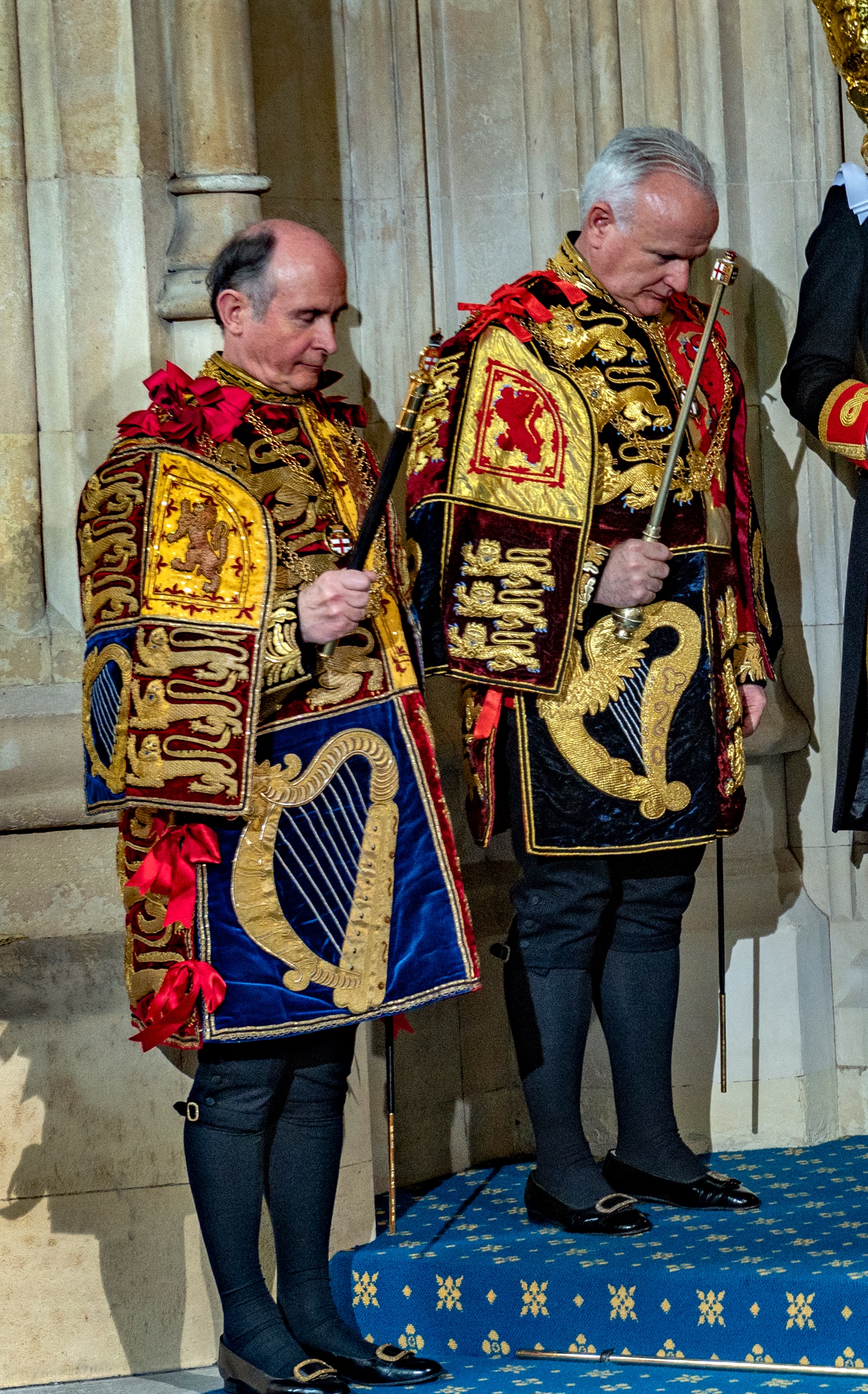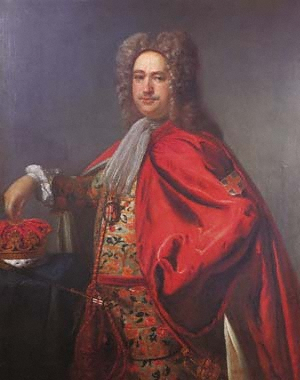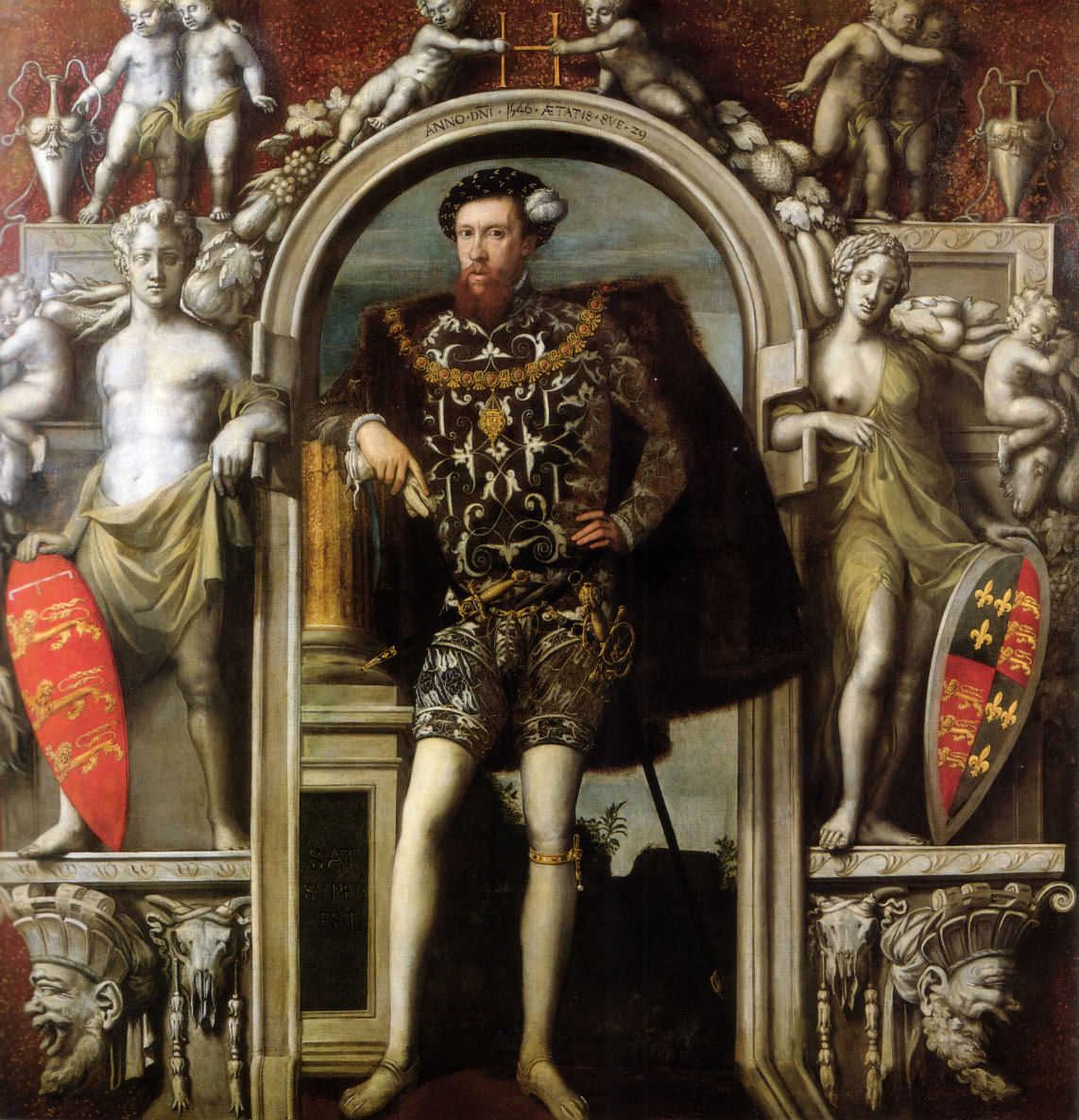|
Christopher Barker (officer Of Arms)
Sir Christopher Barker (died 4 January 1550) was an officer of arms at the College of Arms in the City of London who rose to the highest position of Garter Principal King of Arms. Early years Christopher was the son of William Barker of Stokesley in the North Riding of Yorkshire (now North Yorkshire) and his wife, Joan, the daughter of William Carhill and sister of Sir Christopher Carhill, Norrey King of Arms. In adulthood, he lived in Newbury in Berkshire. Heraldic career Barker started his heraldic career as the private officer of arms of Charles Brandon. Barker was made Lisle pursuivant in 1513 and Suffolk Herald in 1517. He is known to have accompanied his employer on journeys to France in 1514 and 1515. On 1 November 1522 Barker was made a royal officer of arms as Richmond herald. In June 1536 he was promoted to Norroy King of Arms, and was quickly promoted to Garter Principal King of Arms on 15 July. As Garter King of Arms, Barker helped to organize ceremonies such as ... [...More Info...] [...Related Items...] OR: [Wikipedia] [Google] [Baidu] |
Officer Of Arms
An officer of arms is a person appointed by a sovereign or Sovereign state, state with authority to perform one or more of the following functions: * to control and initiate coat of arms, armorial matters; * to arrange and participate in ceremonies of state; * to conserve and interpret heraldry, heraldic and genealogical records. By country The medieval practice of appointing heralds or pursuivants to the establishment of a Nobility, noble household is still common in European countries, particularly those in which there is no official heraldic control or Heraldic authority, authority. Such appointments are also still made in Scotland, where four Private officer of arms, private officers of arms exist. These appointments are all purely advisory. Canada Work completed by the Canadian Heraldic Authority is conducted by officers known as the herald of arms. The organization is led by the Herald Chancellor of Canada and the Chief Herald of Canada, the latter serving as the director ... [...More Info...] [...Related Items...] OR: [Wikipedia] [Google] [Baidu] |
Norroy King Of Arms
Norroy and Ulster King of Arms is the Provincial King of Arms at the College of Heralds with jurisdiction over England north of the Trent and Northern Ireland. The two offices of Norroy and Ulster were formerly separate. Norroy King of Arms is the older office, there being a reference as early as 1276 to a "King of Heralds beyond the Trent in the North". The name ''Norroy'' is derived from the French meaning 'north king'. The office of Ulster Principal King of Arms for All-Ireland was established in 1552 by King Edward VI to replace the older post of Ireland King of Arms, which had lapsed in 1487. Ulster King of Arms was not part of the College of Arms and did not fall under the jurisdiction of the Earl Marshal, being the heraldic authority for the Kingdom of Ireland (the jurisdiction of the College of Arms being the Kingdom of England and Lord Lyon's Office that of the Kingdom of Scotland). Ulster was Registrar and King of Arms of the Order of St Patrick. Norroy and Ulster ... [...More Info...] [...Related Items...] OR: [Wikipedia] [Google] [Baidu] |
Mark Noble (biographer)
Mark Noble (1754–1827) was an English clergyman, biographer and antiquary. Life He was born in Digbeth, Birmingham, the third surviving son of William Heatley Noble, a merchant there. His father sold, among many other commodities, beads, knives, toys, and other trifles which he distributed wholesale among slave traders, and he had also a large mill for rolling silver and for plating purposes. Mark was educated at schools at Yardley, Worcestershire, and Ashbourne, Derbyshire. On the death of his father he inherited a modest fortune, and was articled to Mr. Barber, a solicitor of Birmingham. On the expiration of his indentures he went into business on his own account; but turned to literature and history. In 1781 he was ordained to the curacies of Baddesley Clinton and Packwood, Warwickshire. On the sudden death of the incumbent, Noble was himself presented to the two livings ('starvations,' he called them). Noble, now a married man, took a house at Knowle, Warwickshire, c ... [...More Info...] [...Related Items...] OR: [Wikipedia] [Google] [Baidu] |
Anthony Wagner
Sir Anthony Richard Wagner (6 September 1908 – 5 May 1995) was a long-serving officer of arms at the College of Arms in London. He served as Garter Principal King of Arms before retiring to the post of Clarenceux King of Arms. He was one of the most prolific authors on the subjects of heraldry and genealogy of the 20th century. Early life and education Wagner's distant ancestor, Melchior Wagner, arrived in England from the Saxon city of Coburg in 1709 and became hatter to George I and George II.'Sir Anthony Wagner', ''The Times'' (11 May 1995), p. 21. Wagner's father, Orlando Wagner, ran a day-school in London. He attended Eton College and Balliol College, Oxford, on scholarships. He found the classics uninteresting and graduated with a third in '' Literae humaniores''. From early age he had been interested in genealogy and his favourite book as a boy was Hereford Brooke George's ''Genealogical Tables Illustrative of Modern History''. Professional career Wagner joined the ... [...More Info...] [...Related Items...] OR: [Wikipedia] [Google] [Baidu] |
Dictionary Of National Biography
The ''Dictionary of National Biography'' (''DNB'') is a standard work of reference on notable figures from British history, published since 1885. The updated ''Oxford Dictionary of National Biography'' (''ODNB'') was published on 23 September 2004 in 60 volumes and online, with 50,113 biographical articles covering 54,922 lives. First series Hoping to emulate national biographical collections published elsewhere in Europe, such as the ''Allgemeine Deutsche Biographie'' (1875), in 1882 the publisher George Smith (1824–1901), of Smith, Elder & Co., planned a universal dictionary that would include biographical entries on individuals from world history. He approached Leslie Stephen, then editor of the ''Cornhill Magazine'', owned by Smith, to become the editor. Stephen persuaded Smith that the work should focus only on subjects from the United Kingdom and its present and former colonies. An early working title was the ''Biographia Britannica'', the name of an earlier eighteen ... [...More Info...] [...Related Items...] OR: [Wikipedia] [Google] [Baidu] |
John Anstis
John Anstis (29 August 1669 – 4 March 1744) was an English officer of arms, antiquarian and politician who sat in the House of Commons between 1702 and 1722. He rose to the highest heraldic office in England and became Garter King of Arms in 1718 after years of political manoeuvring. Early life Anstis was born at St Neot, Cornwall on 29 August 1669. He was the first son of another John Anstis and his wife Mary, the daughter of George Smith. Anstis matriculated at Exeter College, Oxford, on 27 March 1685 and entered the Middle Temple on 31 January 1690. On 23 June 1695 he married Elizabeth, daughter and heir of Richard Cudlipp of Tavistock, Devon. They had eight sons and six daughters. Anstis was called to the bar on 19 May 1699. Political life In March 1701, Anstis received permission from the Earl Marshal, Henry Howard, 7th Duke of Norfolk, to collect materials from the College of Arms library to assist in the defence of the jurisdiction of the Earl Marshal, which was under ... [...More Info...] [...Related Items...] OR: [Wikipedia] [Google] [Baidu] |
Officer Of Arms
An officer of arms is a person appointed by a sovereign or Sovereign state, state with authority to perform one or more of the following functions: * to control and initiate coat of arms, armorial matters; * to arrange and participate in ceremonies of state; * to conserve and interpret heraldry, heraldic and genealogical records. By country The medieval practice of appointing heralds or pursuivants to the establishment of a Nobility, noble household is still common in European countries, particularly those in which there is no official heraldic control or Heraldic authority, authority. Such appointments are also still made in Scotland, where four Private officer of arms, private officers of arms exist. These appointments are all purely advisory. Canada Work completed by the Canadian Heraldic Authority is conducted by officers known as the herald of arms. The organization is led by the Herald Chancellor of Canada and the Chief Herald of Canada, the latter serving as the director ... [...More Info...] [...Related Items...] OR: [Wikipedia] [Google] [Baidu] |
Heraldry
Heraldry is a discipline relating to the design, display and study of armorial bearings (known as armory), as well as related disciplines, such as vexillology, together with the study of ceremony, rank and pedigree. Armory, the best-known branch of heraldry, concerns the design and transmission of the heraldic achievement. The achievement, or armorial bearings usually includes a coat of arms on a shield, helmet and crest, together with any accompanying devices, such as supporters, badges, heraldic banners and mottoes. Although the use of various devices to signify individuals and groups goes back to antiquity, both the form and use of such devices varied widely, as the concept of regular, hereditary designs, constituting the distinguishing feature of heraldry, did not develop until the High Middle Ages. It is often claimed that the use of helmets with face guards during this period made it difficult to recognize one's commanders in the field when large armies gathered together ... [...More Info...] [...Related Items...] OR: [Wikipedia] [Google] [Baidu] |
St Faith's Under St Paul's
St Faith under St Paul's in Castle Baynard Ward was an unusual parish within the City of London. It originally had its own building to the east of St Paul's Cathedral, serving as a parish church for the residents of St Paul's Churchyard and Paternoster Row, but this was removed in 1256 to allow for the eastern expansion of the Cathedral. The parishioners were instead given a space to worship within the cathedral crypt. The parish appears as "St Faith within the monastery of St Paul's, London" in 1381, with mention of John Phelip, as a former parson. Until the reign of Edward VI the parishioners worshipped at the end of the west crypt under St Paul’s Quire. Sir Simonds D'Ewes, the diarist, attended the wedding of his father Paul and his stepmother, Lady Elizabeth Denton, in "St. Faith's under St. Paul's" on 5 March 1623, and Sir Simonds's younger sister Mary also married there on 4 December 1626 From the reign of Edward VI until the Great Fire the parishioners, mostly b ... [...More Info...] [...Related Items...] OR: [Wikipedia] [Google] [Baidu] |
Vintners' Company
The Worshipful Company of Vintners is one of the oldest Livery Companies of the City of London, England, thought to date back to the 12th century. It is one of the "Great Twelve" livery companies of London, and its motto is ''Vinum Exhilarat Animum'', Latin for "Wine Cheers the Spirit". One of the more peculiar rights of the Company involves the ceremony of swan upping. History and origins It probably existed as early as the twelfth century, and it received a royal charter in 1364. Due to the royal charter, the company gained a monopoly over wine imports from Gascony. Also, it acquired the right to sell wine without a licence, and it became the most powerful company in the wine trade. However, in 1553, it lost its right to sell wine anywhere in the country. Up to 2006, Vintners retained the right to sell wine without a licence in certain areas, such as the City of London or along the route of the old Great North Road. This right has now been abolished, but limited privilege ... [...More Info...] [...Related Items...] OR: [Wikipedia] [Google] [Baidu] |
Rouge Croix Pursuivant
Rouge Croix Pursuivant of Arms in Ordinary is a junior officer of arms of the College of Arms. He is said to be the oldest of the four pursuivants in ordinary. The office is named after St George's Cross which has been a symbol of England since the time of the Crusades. The post is currently vacant. Holders of the office See also * Heraldry * Officer of Arms Further reading * ''The College of Arms, Queen Victoria Street : being the sixteenth and final monograph of the London Survey Committee'', Walter H. Godfrey, assisted by Sir Anthony Wagner, with a complete list of the officers of arms, prepared by H. Stanford London, (London, 1963) * ''A History of the College of Arms &c'', Mark Noble Mark James Noble (born 8 May 1987) is an English former professional footballer who played as a central midfielder and is well remembered for his time at English club West Ham United, spending eighteen years with the club. Apart from two sh ..., (London, 1804) References External l ... [...More Info...] [...Related Items...] OR: [Wikipedia] [Google] [Baidu] |
Henry Howard, Earl Of Surrey
Henry Howard, Earl of Surrey (1516/1517 – 19 January 1547), Order of the Garter, KG, was an English nobleman, politician and poet. He was one of the founders of English Renaissance poetry and was the last known person executed at the instance of King Henry VIII. He was a first cousin of the king's wives Anne Boleyn and Catherine Howard. His name is usually associated in literature with that of the poet Thomas Wyatt (poet), Sir Thomas Wyatt. Owing largely to the powerful position of his father, Thomas Howard, 3rd Duke of Norfolk, Surrey took a prominent part in the court life of the time, and served as a soldier both in France and Scotland. He was a man of reckless temper, which involved him in many quarrels, and finally brought upon him the wrath of the ageing and embittered Henry VIII. He was arrested, tried for treason and beheaded on Tower Hill. Origins He was born in Hunsdon, Hertfordshire, the eldest son of Thomas Howard, 3rd Duke of Norfolk, by his second wife Elizab ... [...More Info...] [...Related Items...] OR: [Wikipedia] [Google] [Baidu] |




